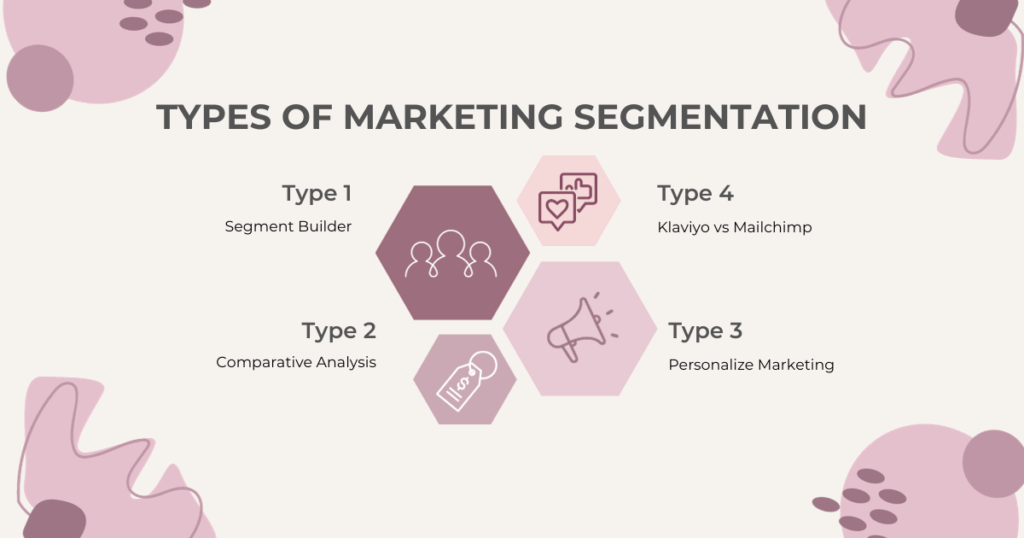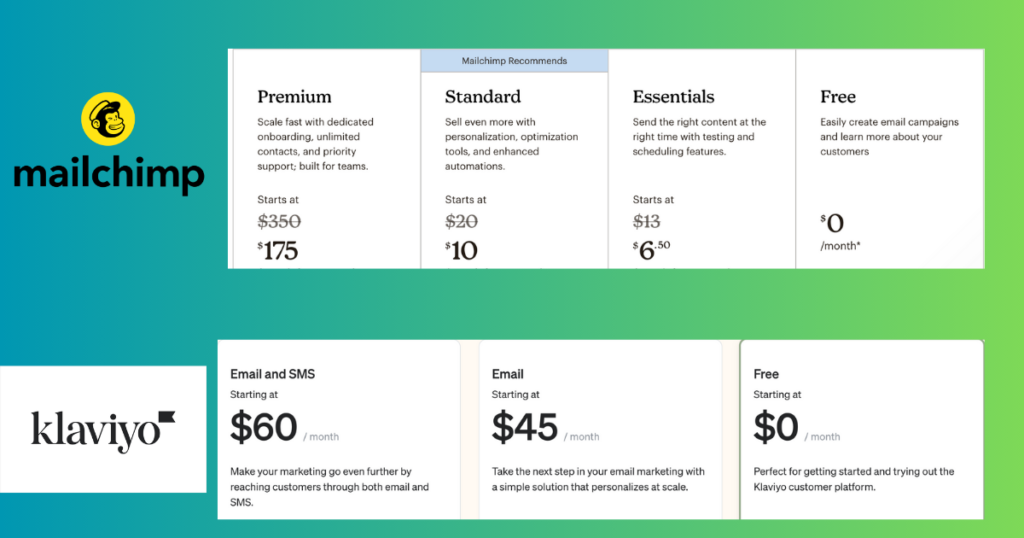Navigating the Klaviyo vs Mailchimp debate is essential for any marketer looking to harness the full potential of email marketing. This blog post provides a numbers-driven deep dive into the strengths and weaknesses of each platform, offering you the insights needed to make an informed decision. Whether you’re looking for advanced automation or user-friendly design, join us as we unravel the features that set these giants apart and help you choose the right ally for your marketing crusade..
Table of Contents
User Interface and Ease of Use
When comparing Klaviyo vs Mailchimp, the user interface (UI) is a critical aspect that directly impacts the user experience. A well-designed UI should be intuitive, allowing users to navigate the platform with ease and perform tasks efficiently.
Klaviyo’s Interface: Klaviyo offers a streamlined and modern interface. New users may encounter a steeper learning curve due to its advanced features and detailed analytics dashboard. However, once familiar with the system, marketers and e-commerce business owners can execute complex automation workflows and campaigns with precision. The platform’s layout is logical, and the menu is well organized, facilitating quick access to different features.

Mailchimp’s Interface: Mailchimp is often celebrated for its user-friendly interface. It’s designed with beginners in mind, ensuring that even users with minimal marketing experience can get started without a hitch. The drag-and-drop email builder and clear labeling of features make campaign creation a breeze. For many, the simplicity of Mailchimp’s UI is a significant advantage, especially for those who prioritize ease of use over advanced functionality.
Comparative Analysis: In the Klaviyo vs Mailchimp debate, the choice between interfaces depends on the user’s proficiency and needs. Klaviyo’s comprehensive features cater to users seeking depth and customization in their marketing strategies, while Mailchimp offers a more approachable platform for those who value simplicity and quick campaign setups.
Email Automation Capabilities
In the realm of email marketing, automation is the ace up the sleeve for any campaign’s efficiency and effectiveness. A pivotal point in the Klaviyo vs Mailchimp discussion hinges on their automation capabilities, which are essential for nurturing leads, engaging customers, and converting sales without manual intervention.
Klaviyo’s Automation: Klaviyo shines in its robust automation features designed for e-commerce businesses. Its ability to trigger emails based on a variety of customer behaviors, like past purchases, browsing activity, and engagement levels, is impressive. This platform allows for highly personalized and targeted email sequences, which can significantly increase conversion rates. Klaviyo also provides automation splits that let you tailor the customer journey based on actions taken, ensuring each subscriber receives the most relevant content.
Mailchimp’s Automation: Mailchimp also offers a range of automation options, which are user-friendly and can be set up quickly. It provides pre-built workflows for common automation tasks such as welcome emails, cart abandonment, and order confirmations. While these are less customizable than Klaviyo’s, they cover the needs of many small to medium-sized businesses and are a good starting point for those new to email automation.
Comparative Analysis: When comparing Klaviyo vs Mailchimp for email automation capabilities, Klaviyo stands out for businesses that require sophisticated, behavior-driven email funnels. In contrast, Mailchimp is the go-to for users who prefer a more straightforward and easy-to-implement automation solution.

Template Design and Customization
Template design and customization are where aesthetics meet functionality, serving as an extension of your brand’s voice and style. In evaluating Klaviyo vs Mailchimp, it’s clear that both platforms understand the importance of visually appealing and customizable email templates.
Klaviyo’s Templates: Klaviyo offers a selection of templates with a modern aesthetic that are fully customizable to match your brand. The platform’s template editor is robust, giving you the freedom to manipulate every aspect of your email design, from button colors to font styles. However, it might be slightly less intuitive for users who do not have much experience with design software.
Mailchimp’s Templates: Mailchimp is renowned for its wide variety of templates and its highly intuitive drag-and-drop editor, which makes customization easy for users of all skill levels. Whether you’re looking to send out a quick announcement or a complex newsletter, Mailchimp has a template for every occasion. The ease of customization allows even those with no design background to create professional-looking emails.
Comparative Analysis: The main difference in Klaviyo vs Mailchimp’s approach to template design and customization lies in the flexibility and user-friendliness of their tools. Klaviyo may offer greater control for fine-tuning, while Mailchimp wins on simplicity and speed of design.
Segmentation and Personalization Features
Effective segmentation and personalization can dramatically improve the relevance and performance of email marketing campaigns. When considering Klaviyo vs Mailchimp, understanding how each platform allows you to target your audience is key to crafting tailored messages that resonate with subscribers.
Klaviyo’s Segmentation and Personalization: Klaviyo excels with its advanced segmentation features, which leverage real-time data to create dynamic customer segments. These segments can be based on a multitude of behaviors and properties, such as purchase history, website activity, and engagement patterns. Personalization is another area where Klaviyo stands out; it allows for deep personalization using data science, enabling you to insert predictive content like product recommendations and optimal send times into your emails.
Mailchimp’s Segmentation and Personalization: Mailchimp offers user-friendly segmentation options that are great for businesses just starting out with personalized marketing. It allows you to create segments based on demographics, behavior, and campaign activity. Mailchimp also includes basic personalization features, like inserting a subscriber’s name or sending birthday emails, which can add a personal touch to your campaigns without requiring complex setup.
Comparative Analysis: The choice between Klaviyo vs Mailchimp for segmentation and personalization depends on the level of sophistication required. Klaviyo is the platform of choice for businesses that need detailed segmentation and are ready to leverage extensive customer data. Mailchimp is better suited for those who prefer simplicity and are looking for an easy way to start personalizing emails.

E-commerce Integration and Functionality
E-commerce integration and functionality are essential for an online business’s marketing strategy, influencing how effectively an email marketing platform can communicate with an e-commerce store. Diving into Klaviyo vs Mailchimp will show how each service caters to online retailers.
Klaviyo’s E-commerce Integration: Klaviyo boasts deep integration capabilities, particularly with e-commerce platforms such as Shopify, Magento, and WooCommerce. These integrations are powerful and allow for the synchronization of customer data in real-time. This real-time data flow enables retailers to create highly targeted and timely marketing campaigns based on customers’ shopping behaviors and patterns. Klaviyo’s functionality is designed to drive sales by triggering personalized emails based on actions like cart abandonment or browsing history.
Mailchimp’s E-commerce Integration: Mailchimp also provides e-commerce integration, with a focus on user-friendliness. While it offers a range of integrations with popular platforms, including Shopify, BigCommerce, and WooCommerce, the depth of integration is generally considered to be less extensive than Klaviyo’s. However, Mailchimp’s easy setup and straightforward tools make it an attractive option for e-commerce businesses looking for a quick and simple solution to start their email marketing efforts.
Comparative Analysis: When it comes to Klaviyo vs Mailchimp for e-commerce integration and functionality, Klaviyo tends to be preferred by businesses looking to leverage detailed customer data for complex campaigns. In contrast, Mailchimp is often the choice for those seeking a more straightforward approach to e-commerce email marketing.
Analytics and Reporting Tools
Analytics and reporting tools are indispensable for measuring the success of email marketing campaigns and making data-driven decisions. In the comparison of Klaviyo vs Mailchimp, we’ll see how each platform helps businesses track their performance and refine their marketing strategies.
Klaviyo’s Analytics: Klaviyo offers comprehensive analytics tools that provide detailed insights into customer behavior and campaign performance. The platform allows you to monitor metrics such as open rates, click-through rates, and conversions in real-time. Additionally, Klaviyo’s revenue attribution feature can show you exactly how much revenue each campaign generates, making it easier to determine your return on investment. The platform’s ability to segment data also means you can get granular with your analysis, examining how different customer groups interact with your emails.
Mailchimp’s Reporting: Mailchimp’s reporting features are known for their user-friendly interface, providing a clear and concise overview of campaign results. You can track standard metrics like open rates, click-through rates, and unsubscribes. Mailchimp also provides visual reports that help you quickly understand your campaign’s performance, including how your emails are contributing to your sales figures.
Comparative Analysis: When weighing Klaviyo vs Mailchimp for analytics and reporting, Klaviyo is generally seen as the more robust option, suited for those who need in-depth analysis and revenue tracking. Mailchimp, on the other hand, is ideal for businesses that require a more straightforward and visually oriented reporting tool.

Email Deliverability and Performance
Email deliverability and performance are crucial for ensuring your messages reach the inbox and engage your audience. The showdown between Klaviyo vs Mailchimp often comes down to their ability to successfully navigate these challenges.
Klaviyo’s Deliverability: Klaviyo prides itself on high deliverability rates, thanks to its robust infrastructure and proactive deliverability monitoring. The platform offers advanced features like A/B testing for subject lines and content, which can improve open rates and overall engagement. Klaviyo also allows users to segment their send times based on when subscribers are most likely to open emails, further enhancing performance.
Mailchimp’s Deliverability: Mailchimp also boasts strong deliverability, supported by its longstanding reputation and sophisticated email sending practices. It provides users with a suite of tools to optimize email performance, including testing and feedback on email design and subject lines. Additionally, Mailchimp’s Time Warp feature sends emails according to each subscriber’s local time, potentially improving open rates.
Comparative Analysis: In terms of Klaviyo vs Mailchimp, both platforms offer solid deliverability and performance features. The choice may come down to the specific needs of a business—whether it’s Klaviyo’s detailed segmentation and A/B testing capabilities or Mailchimp’s user-friendly optimization tools.
Customer Support and Community
Customer support and a strong user community are invaluable resources for any email marketing service user. In the Klaviyo vs Mailchimp comparison, we’ll examine how each platform assists its users and fosters a supportive community.
Klaviyo’s Support and Community: Klaviyo provides its users with a range of support options, including email and chat. They are known for their detailed knowledge base and educational resources, which offer valuable guidance for troubleshooting and optimizing campaigns. Klaviyo also has a community forum where users can exchange ideas, strategies, and provide mutual support. Additionally, Klaviyo hosts regular webinars and training sessions for users to improve their marketing skills.
Mailchimp’s Support and Community: Mailchimp has a reputation for accessible customer support with a comprehensive help center, email, and live chat options. Their guides and tutorials are user-friendly and cover a wide array of topics, from getting started to advanced campaign tactics. Mailchimp’s community is also active, with forums and social media groups where users can connect, share experiences, and learn from each other.
Comparative Analysis: When it comes to customer support and community, both Klaviyo vs Mailchimp offer strong support networks, though the way they deliver this support may vary. Klaviyo’s educational resources are particularly strong in analytics and automation, while Mailchimp’s are widely regarded for their simplicity and ease of use for beginners.

Klaviyo vs Mailchimp: Pricing and Plans Comparison
When choosing an email marketing platform, understanding the differences in pricing and plans is crucial. In this comparison of Klaviyo vs Mailchimp, we’ll examine how each platform structures its pricing and what you get at different plan levels, helping you decide which fits your business needs best.

Overview of Pricing Structures
Klaviyo Pricing: Klaviyo operates on a sliding scale pricing model that grows with your business. The cost is primarily based on the number of contacts in your email list. It starts with a free option for up to 250 contacts, which is ideal for small businesses or those just starting out. As your contact list expands, the pricing increases accordingly.
Mailchimp Pricing: Mailchimp offers a more varied pricing structure, including a free plan that supports a larger number of contacts than Klaviyo’s free option. The paid plans vary not only with the number of contacts but also with the features you need. This makes Mailchimp an attractive option for businesses that are scaling and need more sophisticated marketing tools.
Detailed Plan Comparison
1. Free Plans:
- Klaviyo: Offers basic email sending capabilities, ideal for very small businesses or startups.
- Mailchimp: Provides a more generous free plan with additional features like basic templates and marketing CRM.
2. Entry-Level Paid Plans:
- Klaviyo: Starts to include more advanced features like automation and segmentation as the contact list grows.
- Mailchimp: Adds support for custom branding and A/B testing, appealing to businesses with evolving marketing needs.
3. Higher-Level Plans:
- Klaviyo: These plans are more suited for large businesses with extensive email lists and advanced marketing needs, including more detailed analytics and reporting.
- Mailchimp: Offers comprehensive features such as multivariate testing and advanced audience insights, targeting large-scale operations.
Pros and Cons: Klaviyo vs Mailchimp
When it comes to selecting the right email marketing tool for your business, it’s crucial to weigh the pros and cons. In this comparison of Klaviyo vs Mailchimp, we will delve into the strengths and weaknesses of each platform, providing a clear perspective to help you make an informed decision.
Klaviyo: Pros and Cons
Pros:
- Advanced Segmentation: Klaviyo offers powerful segmentation tools, allowing for highly targeted email campaigns.
- E-commerce Integration: It seamlessly integrates with e-commerce platforms, especially Shopify, making it a favorite for online retailers.
- Automation: Klaviyo’s automation capabilities are robust, enabling sophisticated and personalized email sequences.
- Data-Driven Analytics: Provides detailed analytics to track and optimize the performance of email campaigns.
Cons:
- Pricing: Klaviyo can be more expensive, especially as your contact list grows, which might not be ideal for small businesses.
- Learning Curve: Its advanced features come with a steeper learning curve compared to Mailchimp.
- Limited Free Plan: The free plan offers limited features, making it less attractive for businesses not ready to invest in a paid plan.
Mailchimp: Pros and Cons
Pros:
- User-Friendly Interface: Mailchimp is known for its ease of use, making it ideal for beginners.
- Generous Free Plan: Offers a more comprehensive free plan than Klaviyo, suitable for small businesses and startups.
- Template Variety: Provides a wide range of customizable templates, catering to those who prioritize design.
- Marketing CRM: Mailchimp includes basic CRM features, helping businesses manage customer relationships effectively.
Cons:
- Less Advanced Segmentation: While still powerful, Mailchimp’s segmentation tools are not as advanced as Klaviyo’s.
- E-commerce Integration: Although it integrates with e-commerce platforms, the integration is not as deep as Klaviyo’s.
- Limited Automation in Lower Plans: Advanced automation features are not available in the lower-tier plans.
Case Studies and Success Stories: Klaviyo vs Mailchimp
Exploring case studies and success stories is a great way to understand the real-world impact of email marketing platforms. In this examination of Klaviyo vs Mailchimp, we’ll look at how different businesses have leveraged these tools to achieve their marketing goals.
Klaviyo: Transforming E-commerce Marketing
Case Study 1: Fashion Retailer’s Growth A fashion retailer, previously struggling with segmentation and personalized marketing, switched to Klaviyo. By utilizing Klaviyo’s advanced segmentation and automation features, they reported a 150% increase in email-driven revenue within six months.
Key Takeaways:
- Advanced segmentation allowed for highly targeted campaigns.
- Integration with their e-commerce platform streamlined marketing efforts.
Case Study 2: Boosting Engagement for a Beauty Brand A beauty brand used Klaviyo’s data-driven analytics to revamp its email marketing strategy. This led to a 50% increase in customer engagement and a significant boost in repeat purchases.
Key Takeaways:
- Personalized email campaigns based on customer data were highly effective.
- Detailed analytics helped in understanding customer preferences.
Mailchimp: Empowering Diverse Businesses
Case Study 1: Small Business Success A small online bookstore used Mailchimp to create visually appealing newsletters and announcements. Leveraging Mailchimp’s user-friendly interface and template designs, they saw a 40% increase in newsletter sign-ups and a notable improvement in sales.
Key Takeaways:
- Easy-to-use templates helped in creating attractive emails.
- The free plan was sufficient for their initial growth phase.
Case Study 2: Non-Profit’s Outreach Expansion A non-profit organization utilized Mailchimp to manage its large contact list and send out periodic updates and donation campaigns. Their campaigns became more effective, resulting in a 30% increase in donor engagement.
Key Takeaways:
- The scalability of Mailchimp supported the growth of their contact list.
- User-friendly features made it easy to manage large-scale campaigns.
Conclusion
These case studies highlight that the choice between Klaviyo vs Mailchimp depends largely on your business needs and goals. Klaviyo shines in advanced segmentation and integration for e-commerce, while Mailchimp excels in user-friendliness and versatility, catering to a wide range of businesses.
Future Outlook and Updates: Klaviyo vs Mailchimp
In the rapidly evolving world of email marketing, staying abreast of future trends and updates is crucial for businesses. This article explores the future outlook for Klaviyo and Mailchimp, highlighting anticipated updates and how they might impact users of these platforms.

Klaviyo: Anticipated Developments
Klaviyo has consistently focused on advancing its data analytics and segmentation capabilities, and this trend is expected to continue. Future updates may include:
- Enhanced AI-driven Insights: Klaviyo is likely to integrate more advanced AI tools to provide deeper insights into customer behavior and campaign effectiveness.
- Improved E-commerce Integration: Continuous enhancement of e-commerce integrations, especially with emerging platforms, is anticipated.
- User Interface Improvements: Efforts to make the platform more user-friendly, reducing the learning curve for new users.
Mailchimp: Future Enhancements
Mailchimp has been expanding its capabilities beyond email marketing, moving towards becoming an all-in-one marketing platform. Expected updates include:
- Broadened CRM Features: Further development of its CRM functionalities to offer a more integrated marketing experience.
- Enhanced Automation and Personalization: Enhancements in automation and personalization features to match the growing needs of diverse businesses.
- Expansion of Integration Ecosystem: Increasing the range of integrations with other tools and platforms, facilitating a more seamless workflow.
Comparative Outlook
In the Klaviyo vs Mailchimp discussion, it’s clear that both platforms are gearing up to meet future challenges:
- Klaviyo is focusing on maintaining its edge in advanced analytics and e-commerce integrations, appealing to data-driven marketers and online retailers.
- Mailchimp is evolving into a more holistic marketing solution, which might attract a broader range of businesses, including small to medium-sized enterprises and startups.
Conclusion
Both Klaviyo and Mailchimp are adapting to the future of digital marketing with their own unique approaches. The choice between them should consider not only their current capabilities but also their future development trajectories, ensuring a platform that grows with your business.
Conclusion: Which One Suits Your Needs?
Choosing between Klaviyo and Mailchimp ultimately depends on your business’s unique requirements and goals. This conclusion aims to encapsulate the key points of each platform to assist you in making an informed decision that aligns with your needs.

Understanding Your Business Needs
- Size and Type of Business: Smaller businesses or startups might lean towards Mailchimp for its user-friendly interface and generous free plan. In contrast, medium to large businesses, especially those in e-commerce, may find Klaviyo’s advanced features more beneficial.
- Budget Considerations: Klaviyo can be more expensive, particularly as your contact list grows. Mailchimp offers a more flexible pricing structure, which can be more economical for businesses with tight budgets.
Key Differentiators
- Advanced Features: Klaviyo excels in advanced segmentation, automation, and integration with e-commerce platforms, making it a powerhouse for data-driven marketing strategies.
- Ease of Use: Mailchimp is renowned for its ease of use, with an intuitive interface and a wide variety of templates, making it ideal for beginners or businesses that prioritize simplicity in their campaigns.
Final Recommendations
- Choose Klaviyo if: You are an e-commerce business looking for deep analytics, advanced segmentation, and powerful automation capabilities. Klaviyo’s strength in data-driven marketing can significantly boost your targeted campaigns.
- Opt for Mailchimp if: You need an all-in-one marketing platform that is easy to use, with a range of templates and a flexible pricing model. Mailchimp is particularly suitable for small to medium-sized businesses, non-profits, and startups.
Taking the Next Step
Before finalizing your decision, consider taking advantage of free trials or demos offered by both platforms. This hands-on experience can provide valuable insights into which platform aligns best with your workflow and marketing objectives.





